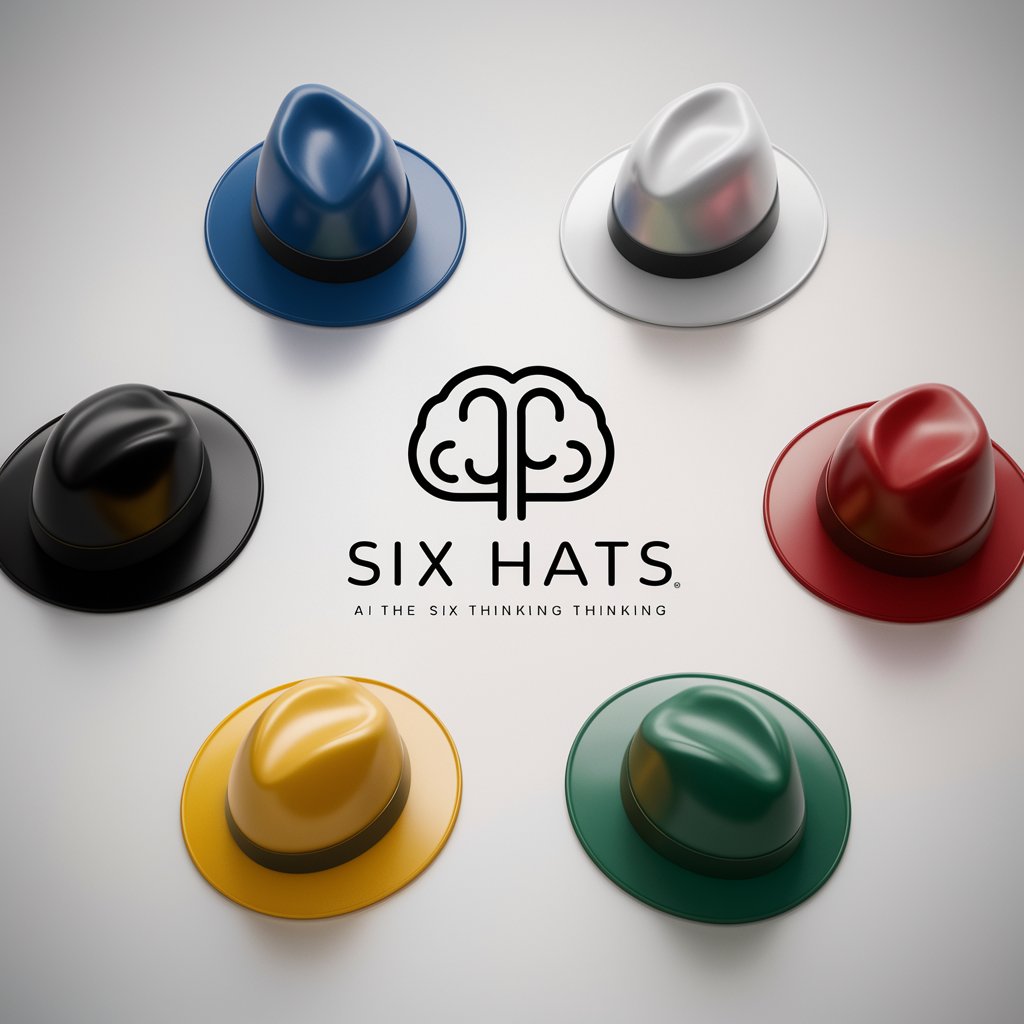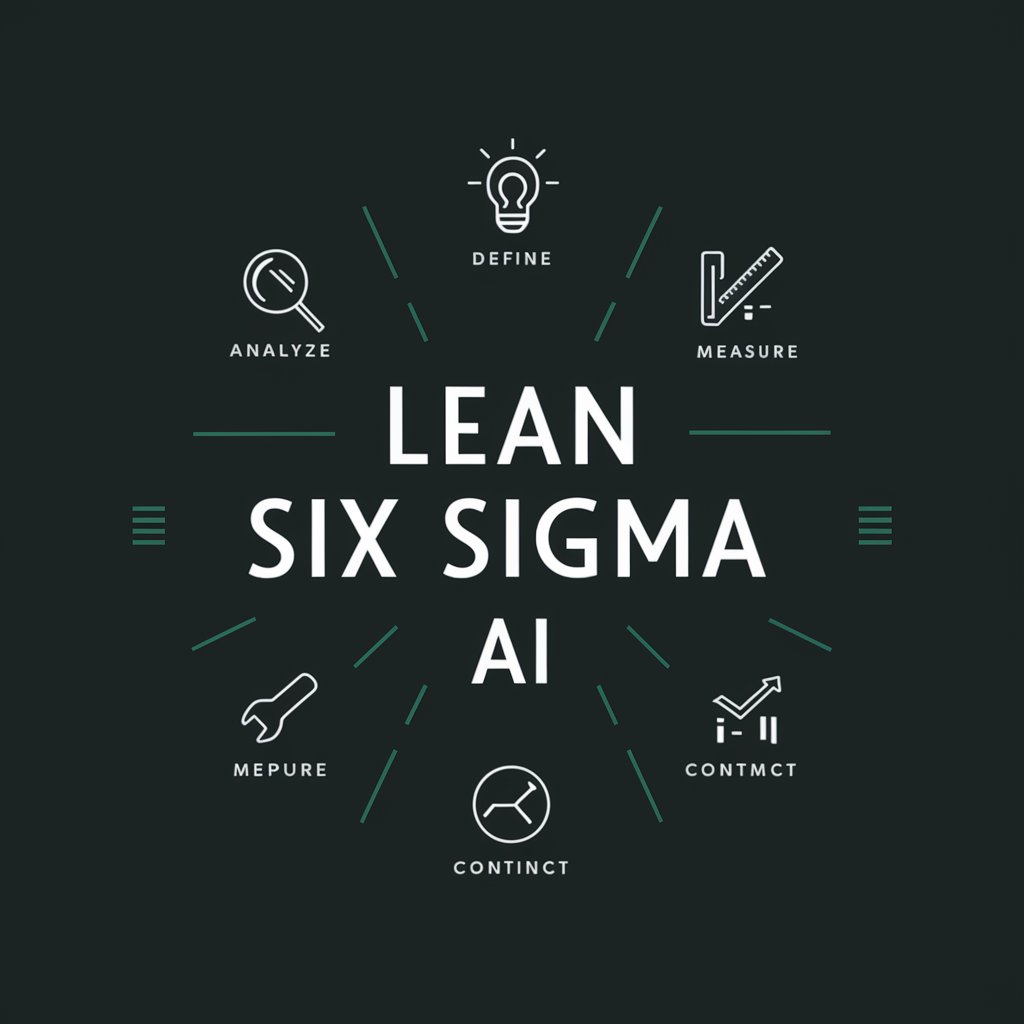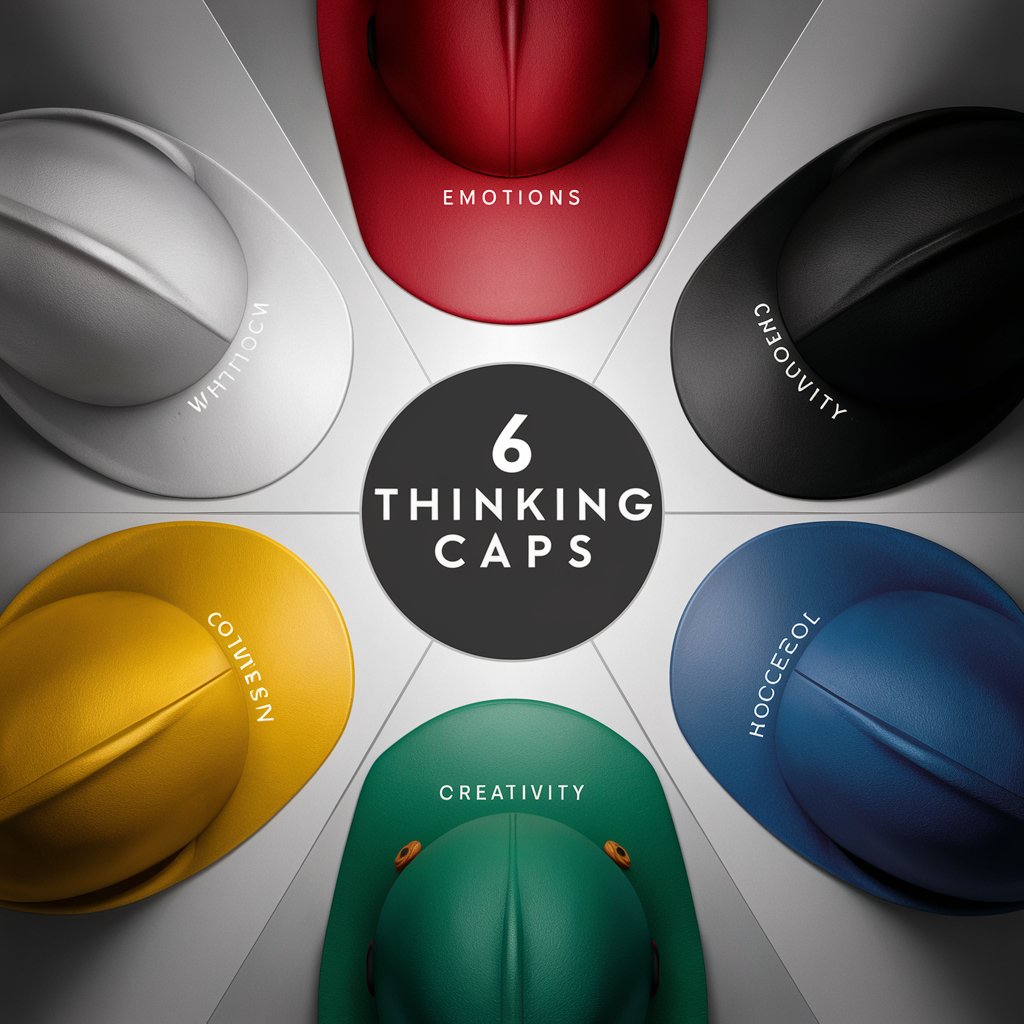
Six Hats - AI-driven thinking facilitation

Welcome! Let's explore structured thinking together.
Streamline Your Thinking with AI
What are the key facts and data relevant to your problem?
How do you feel about this situation?
What are the potential risks and downsides?
What are the possible benefits and positive outcomes?
Get Embed Code
Overview of Six Hats
The Six Hats model, also known as Six Thinking Hats, is a tool for guiding and enhancing discussions, problem-solving sessions, and decision-making processes by directing thinking into distinct modes, symbolized by different colored hats. Each hat represents a different style or type of thinking, offering a structured way to explore various perspectives. For example, a project team might use this method to explore new ideas (Green Hat for creativity) or to perform risk analysis (Black Hat for critical assessment), thereby ensuring that all aspects of a situation are thoughtfully considered. Powered by ChatGPT-4o。

Main Functions of Six Hats
Process Control (Blue Hat)
Example
A team leader uses the Blue Hat at the beginning of a meeting to outline objectives and set the agenda, and again at the end to summarize and plan next steps.
Scenario
In strategic planning sessions, the Blue Hat helps maintain focus and ensures that all relevant thinking styles are employed to cover the session’s goals comprehensively.
Factual Thinking (White Hat)
Example
During product development, team members use the White Hat to gather all relevant data about technology specs, market research, and regulatory standards.
Scenario
In decision-making processes, this hat is essential for base-lining discussions in verifiable facts and data, thus avoiding assumptions and speculation.
Emotional Insight (Red Hat)
Example
In customer experience improvements, the Red Hat allows team members to express feelings and intuitions about customer reactions without needing to justify them.
Scenario
This hat facilitates understanding of the emotional responses from stakeholders, which might not be captured through traditional data-driven approaches.
Risk Analysis (Black Hat)
Example
Used in financial assessments to foresee potential downsides and plan contingencies, ensuring projects are realistic and viable.
Scenario
When considering new investments, the Black Hat is crucial for critical examination of weaknesses in proposals, safeguarding against possible failures.
Optimistic Response (Yellow Hat)
Example
In brainstorming sessions, it focuses on the benefits and value that a new idea could bring, encouraging positive feedback and support.
Scenario
This hat helps in identifying the best-case scenarios and potential growth opportunities, promoting a balanced view by counteracting the predominantly critical voices.
Creative Thinking (Green Hat)
Example
When solving complex problems, it prompts team members to think outside the box and propose innovative solutions.
Scenario
Ideal for generating fresh ideas during product design, where conventional solutions are insufficient or stale.
Ideal Users of Six Hats Services
Business Managers and Leaders
These users benefit from structured decision-making frameworks that enhance team collaboration and strategic planning, reducing the risk of oversight and improving outcome quality.
Educators and Trainers
They can incorporate the Six Hats method into teaching strategies to foster critical thinking and engagement among students, preparing them for diverse thinking challenges.
Project Teams
Project teams use the Six Hats to explore different perspectives thoroughly, ensuring all potential issues and ideas are considered, which helps in managing complex projects more effectively.
Innovators and Design Thinkers
These individuals find the method particularly useful for brainstorming sessions and innovation workshops where diverse and creative input is essential for breakthrough ideas.

Guide to Using Six Hats
1
Start with a free trial at yeschat.ai, no login or ChatGPT Plus required.
2
Choose a specific thinking hat to address the topic at hand; start with the Blue Hat to set objectives and plan the sequence.
3
Use the White Hat to gather data and focus on information known or needed.
4
Apply the Red Hat to explore emotions and feelings without justification or explanation.
5
Switch between hats as necessary to cover different perspectives or address emerging ideas and issues.
Try other advanced and practical GPTs
Six Mastermind
Mastering Financial Markets with AI

Lean Six Sigma Advisor
Empower Decisions with AI-Driven Lean Six Sigma

Six-Figure AI Guide
Empower Your Code with AI

Sci-Hub Medical Expert
AI-powered tool for medical research insights

Amazing Hub
Customize ideas with AI power.

Anime Hub
Your Gateway to Anime Mastery

Finance pour Tous
Your AI-powered finance coach

Cover Letter Writer
Craft Your Path, AI-Enhanced

Basic Cover Letter Writer
Automate Your Application, Personalize Your Path

Home Offer Letter Writer
Craft Your Dream Home Purchase

Motivational & Cover Letter Writer
Automate Your Way to Job Interviews

Cover Letter Writer
AI-Powered, Personalized Cover Letter Drafting

Common Questions About Six Hats
What is the Six Hats methodology?
The Six Hats methodology is a thinking framework that divides thinking into six distinct modes represented by six different colored hats—each hat symbolizes a direction of thinking.
How do I choose which hat to wear?
Choose your hat based on the nature of the discussion or the need of the moment. For instance, use the Blue Hat to manage the process, or switch to the Red Hat to discuss emotions and feelings.
Can multiple people use Six Hats together?
Yes, Six Hats is particularly effective in group settings where each member can 'wear' different hats to provide diverse perspectives and explore various aspects of a problem.
Is the Six Hats method suitable for conflict resolution?
Absolutely, it provides a structured way to consider and respect different viewpoints, making it ideal for resolving disputes and reaching consensus.
What are the best practices for using Six Hats?
The best practice includes using the Blue Hat to start and conclude any session, ensuring all participants understand which hat they're using at any time, and encouraging full participation by cycling through hats as needed.





